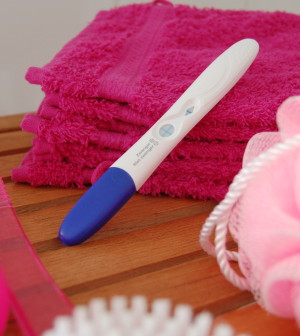- Skip Storing This Everyday Product in the Fridge Door
- Green Tea + B3 Pairing May Boost Brain Health
- Navigating Your Midlife Crisis: Embracing New Possibilities
- City Raccoons Showing Signs of Domestication
- Mapping the Exposome: Science Broadens Focus to Environmental Disease Triggers
- One Week Less on Social Media Linked to Better Mental Health
- Your Brain Changes in Stages as You Age, Study Finds
- Some Suicide Victims Show No Typical Warning Signs, Study Finds
- ByHeart Formula Faces Lawsuits After Babies Sickened With Botulism
- Switch to Vegan Diet Could Cut Your Greenhouse Gas Emissions in Half
More U.S. Women Having Kids in Their 30s and 40s: Report


FRIDAY, Sept. 6More women are waiting until later in life to have children, U.S. health officials reported Friday.
The birth rate for women in their 30s and early 40s rose in 2012, even as birth rates for teenagers and young adults declined to record lows, according to figures released by the U.S. Centers for Disease Control and Prevention.
The rise in the number of births to older women was not surprising to Dr. Edward McCabe, chief medical officer for the March of Dimes.
“If we just look at our anecdotal experience with women who are friends and colleagues, we know a lot of women are delaying birth until later in life,” McCabe said.
Preterm births fell in 2012, as they have done since 2006, the CDC reported. This news comes during the 10th anniversary of the March of Dimes’ campaign to reduce preterm births, McCabe said.
“Back in 2003, it was quite lonely because it seemed like rising prematurity [was] one of those intractable problems,” he said, noting this is the sixth consecutive year that the preterm rate has decreased.
There were about the same overall number of births in 2012 as the year before — 3.95 million — arresting a decline in the United States birth rate that had occurred between 2007 and 2011.
Birth rates for women aged 30 to 34 increased by 1 percent in 2012 to about 97 births per 1,000 women, while the birth rate for women aged 35 to 39 increased by 2 percent to about 48 births per 1,000 women.
The birth rate for women aged 40 to 44 also increased by 1 percent, to 10.4 births per 1,000 women.
McCabe said the trend toward having children later in life is somewhat troubling, given that the risk of birth defects, autism and other childhood disorders increases with maternal age.
“It’s something we want to follow,” he said. “It’s important for women to know the risks for certain birth defects and risks for preterm birth may increase with age. It’s important for women to be knowledgeable about those risks, to the extent they plan their pregnancies and get a pre-conception health assessment so they go into a pregnancy as healthy as possible.”
At the same time, teen births reached a historic low in 2012. The number of births to girls ages 15 to 19 dropped 7 percent to about 305,000 — the fewest since the end of World War II. The 2012 total is nearly one-third fewer than in 2001 and less than half of the 1970 all-time peak of more than 640,000 teen births.
Improved use of contraceptives might be contributing to the continued decline in teen births, McCabe said.
“Last year there was some discussion that more teenagers are using birth control, and more were using more than one form of birth control,” he said. “People were attributing that message getting out to teenagers as being important in this decrease.”
Births among women in their 20s also continued to decline, a trend that has been occurring since 2008. The birth rate for women in their early 20s reached a new record low of about 83 births per 1,000 women.
McCabe chalked up the improvement in preterm births to the message getting out to women that they should have natural childbirth if possible and delay labor until it begins on its own.
“Certainly some women need to deliver early for their health and their baby’s health, but otherwise they really should wait until 39 weeks,” he said. “We now know that even in early term — 37 and 38 weeks — the outcome is very different than full term at 39 and 40 weeks. The mortality rate is higher.”
The rate of births by cesarean section remained unchanged in 2012, however. A third of all births occurred via cesarean delivery.
“If you consider that the rate had been going up steadily prior to the last couple of years, then this is an improvement if you’re looking for a decline in cesarean delivery,” said report co-author Joyce Martin, a statistician at the CDC’s National Center for Health Statistics.
More information
To view more birth data, visit the U.S. National Center for Health Statistics.
Source: HealthDay
Copyright © 2025 HealthDay. All rights reserved.










